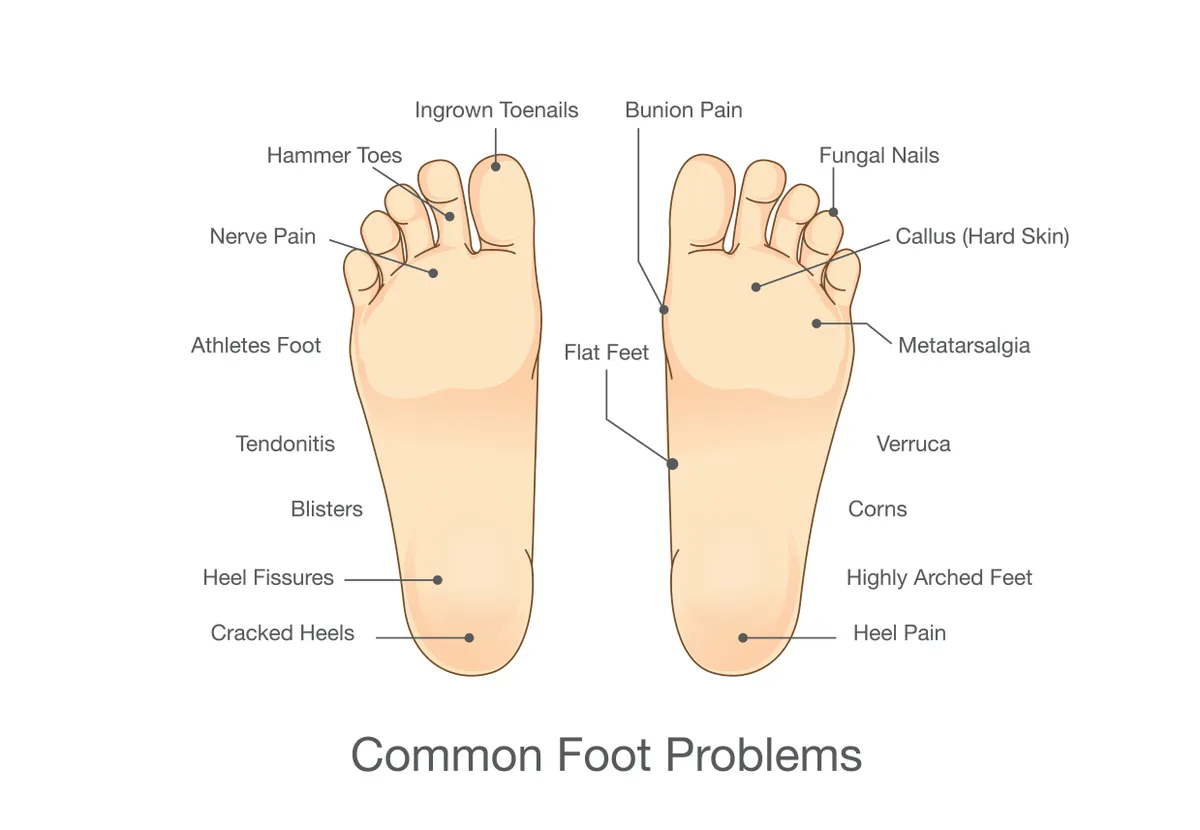Discover effective solutions for Morton’s Neuroma, a debilitating foot condition causing sharp pain between toes. Learn about causes, symptoms, and innovative treatments for lasting relief.
Introduction
Morton’s Neuroma is a distressing foot ailment characterized by severe pain and numbness between the third and fourth toes, stemming from nerve tissue thickening. This condition, often triggered by irritation, repetitive stress, or compression, can significantly impact your daily life. Our guide delves into the causes, symptoms, diagnosis, and cutting-edge treatments to help you step back into comfort and regain your foot health.

Table of Contents
Causes of Morton’s Neuroma
Morton’s Neuroma is a condition characterized by the thickening of the tissue surrounding a nerve in the foot, typically between the third and fourth toes. Several factors can contribute to the development of Morton’s Neuroma:
High-Impact Activities
- Engaging in high-impact activities, such as running, jumping, or participating in sports that involve repetitive foot movements, can subject the feet to excessive pressure.
- The repetitive pounding and impact during these activities may lead to irritation and compression of the nerve, potentially causing Morton’s Neuroma over time.
Ill-Fitting Footwear
- Wearing shoes that do not provide adequate room for the toes and squeeze them together can be a significant contributing factor to Morton’s Neuroma.
- Narrow or tight footwear, especially high heels, can compress the metatarsal bones in the front of the foot and put additional pressure on the nerves.
- Over time, this compression can lead to the formation of Morton’s Neuroma.

Understanding the Symptoms
Recognizing the symptoms associated with Morton’s Neuroma is crucial for early detection and intervention. Common symptoms include:
| Sharp, Burning Pain |
| Individuals with Morton’s Neuroma often experience a sharp, burning pain in the ball of the foot, typically between the third and fourth toes. |
| Tingling or Numbness |
| Tingling or numbness sensations may radiate into the toes, creating discomfort and altered sensation in the affected area. |
| Feeling of a Foreign Object |
| Many individuals with Morton’s Neuroma describe a sensation as if there is a foreign object, like a pebble or a small lump, inside their shoe, despite nothing being there. |
| Symptoms Aggravated by Activity |
| Pain and discomfort associated with Morton’s Neuroma often worsen with physical activity, particularly activities that involve bearing weight on the forefoot. |
| Symptoms Relieved by Rest |
| On the contrary, symptoms tend to improve when the foot is at rest and relieved of weight-bearing pressure. |
Diagnosis
Diagnosing Morton’s Neuroma involves a combination of clinical evaluation and, in some cases, imaging tests. The diagnostic process may include:
| Physical Examination: A healthcare provider will conduct a thorough examination of the foot, including palpation and applying pressure to the affected area. A positive finding known as “Mulder’s sign” involves a clicking sensation when pressure is applied to the neuroma. |
| Discussion of Symptoms: A detailed discussion of the patient’s symptoms, including when they occur and their severity, helps in establishing the diagnosis. |
| Imaging Tests: In some instances, imaging tests such as magnetic resonance imaging (MRI) or ultrasound may be used to confirm the diagnosis by visualizing the neuroma and assessing its size and location. |
Early diagnosis and appropriate treatment can help alleviate symptoms and prevent the progression of Morton’s Neuroma. Patients experiencing symptoms or suspecting the condition should seek professional medical evaluation and guidance.
Potential Treatments
The treatment of Morton’s Neuroma varies depending on the severity of the condition. Initially, conservative measures are often attempted to alleviate symptoms. If these methods prove ineffective, more advanced treatments, including surgical intervention, may be considered.
Footwear Modification
Wearing shoes with a wide toe box can help alleviate pressure on the affected area. These shoes provide ample space for the toes to move freely, reducing compression on the nerve.
Orthotic Inserts
Custom or over-the-counter orthotic inserts can provide support and help distribute pressure more evenly across the foot. They can reduce strain on the foot and potentially ease discomfort.

Steroid Injections
Steroid injections directly into the affected area can help reduce inflammation and provide temporary pain relief. These injections are administered by a healthcare professional.
Physical Therapy
Physical therapy may be recommended to strengthen the muscles in the foot, improve flexibility, and promote proper biomechanics. This can help alleviate symptoms and prevent recurrence.

Cold Therapy (Ice)
Applying ice to the painful area can help reduce inflammation and temporarily alleviate pain. Cold therapy is typically used for short-term relief.
Decompression Surgery
In cases where conservative treatments fail to provide relief, surgical intervention may be considered. Decompression surgery involves releasing the affected nerve from compression. It can provide long-term relief from Morton’s Neuroma symptoms.
Prevention
While it may not always be possible to completely prevent Morton’s Neuroma, certain proactive measures can reduce the risk of developing this condition:
Properly Fitting Footwear
Wearing shoes that fit correctly and allow for adequate toe space is essential. Avoid tight, narrow shoes that squeeze the toes together, as they can contribute to neuroma development.
Activity Modification
Avoid repetitive high-impact activities that place excessive strain on the feet, especially if you are prone to foot issues. Alternating activities and incorporating lower-impact exercises can help reduce the risk.
Regular Breaks
During activities that involve prolonged standing or walking, take regular breaks to rest your feet and relieve pressure. Proper footwear and supportive insoles can aid in this regard.
Maintain a Healthy Weight
Maintaining a healthy body weight can help minimize stress on the feet and lower limbs, reducing the likelihood of developing Morton’s Neuroma and other foot conditions.
By implementing these preventive strategies and seeking appropriate treatment if symptoms arise, individuals can better manage and reduce the impact of Morton’s Neuroma on their foot health and overall quality of life.
Frequently Asked Questions
Q: What is Morton’s Neuroma?
A: Morton’s Neuroma is a foot condition where the tissue around a nerve leading to the toes thickens, causing pain and numbness, primarily between the third and fourth toes.
Q: What causes Morton’s Neuroma?
A: It’s often caused by high-impact activities, ill-fitting footwear, and repetitive stress that leads to nerve irritation and compression.
Q: How is Morton’s Neuroma diagnosed?
A: Diagnosis involves a physical examination, symptom discussion, and possibly imaging tests like MRI or ultrasound to confirm the presence of the neuroma.
Q: What treatments are available for Morton’s Neuroma?
A: Treatments range from conservative methods like footwear modification and orthotic inserts to more advanced options such as steroid injections, physical therapy, and even surgery for severe cases.
Conclusion
Morton’s Neuroma can profoundly affect your quality of life by causing persistent foot pain and discomfort. However, understanding its causes, recognizing symptoms early, and exploring available treatments can empower you to address this condition effectively. Whether through conservative measures or surgical intervention, it’s possible to alleviate the pain of Morton’s Neuroma and improve your foot health. Don’t let foot pain hold you back; seek professional advice at the first sign of discomfort to ensure the best possible outcome.











Simply want to say your article is as surprising. The clarity in your post is simply excellent and i could assume
you’re an expert on this subject. Fine with your permission let me to grab your feed to
keep updated with forthcoming post. Thanks a
million and please carry on the gratifying work.
You really make it appear so easy together with your presentation but I find this matter to be really one thing that I believe I might never understand.
It seems too complex and extremely extensive for me. I am looking forward in your subsequent put
up, I’ll try to get the hold of it!
Hi there it’s me, I am also visiting this website on a regular basis, this site
is genuinely nice and the visitors are really sharing pleasant thoughts.